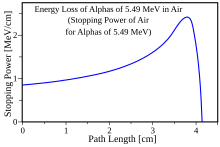Bragg chiam-hong



Bragg tsiam-hong (ing-gú: Bragg peak, stopping power; Bragg khiok-suànn (Bragg curve)) sī Bragg khiok-suànn tíng-kuân ê tsi̍t-ê bîng-hián ê -tsiam-hong, Bragg hong huē-tsè tshut tiān-lî hok-siā teh tshuan-kuè bu̍t-tsit sî-tsūn ê lîng-liōng sún-sit. Tui-tio̍h iông-tsí, α siā-suànn kah kî-thann ê lî-tsí siā-suànn, tsiam-hong ti̍t tshut-hiān teh lia̍p-tsí tio̍h-beh tsīng-tsí tsìn-tsîng. Bragg tsiam-hong sī-í 1903-nî huat-hiān-tsiá William Henry Bragg ê sènn lâi bīng-miâ.[1]
Tsù-kái[siu-kái | kái goân-sí-bé]
- ↑ Charlie Ma, C-M; Lomax, Tony (2012). Proton and carbon ion therapy. Boca Raton: CRC Press. p. 4. ISBN 9781439816073.
Tsham-ua̍t[siu-kái | kái goân-sí-bé]
- Stopping power (particle radiation)
- Bremsstrahlung
- Linear energy transfer
- Proton therapy
Guā-pōo liân-kiat[siu-kái | kái goân-sí-bé]
- Wagenaar, Douglas (1995). "7.1.3 The Bragg Curve". Radiation Physics Principles. goân-loē-iông tī 1 March 2016 hőng khó͘-pih. 27 January 2016 khòaⁿ--ê.
- "Bragg peak". Oxford Reference. Oxford University Press. 27 January 2016 khòaⁿ--ê.
- Hojo, Hidehiro (3 July 2017). "Difference in the relative biological effectiveness and DNA damage repair processes in response to proton beam therapy according to the positions of the spread out Bragg peak". Radiation Oncology. 12 (1): 111. doi:10.1186/s13014-017-0849-1. PMC 5494883
 . PMID 28673358.
. PMID 28673358. - Endo, Masahiro (20 October 2017). "Robert R. Wilson (1914–2000): the first scientist to propose particle therapy—use of particle beam for cancer treatment". Radiological Physics and Technology. 11 (1): 1–6. doi:10.1007/s12194-017-0428-z. PMID 29058267.
- Grun, Rebecca (10 January 2017). "Systematics of relative biological effectiveness measurements for proton radiation along the spread out Bragg peak: experimental validation of the local effect model". Physics in Medicine and Biology. 62 (3): 890–908. doi:10.1088/1361-6560/62/3/890. PMID 28072575. 19 March 2021 khòaⁿ--ê.
